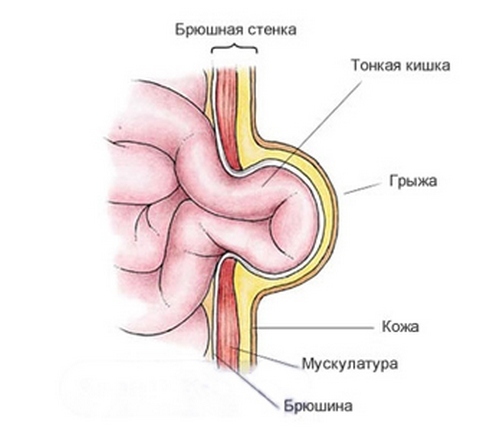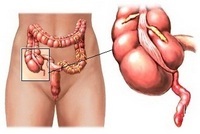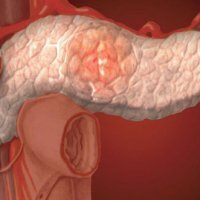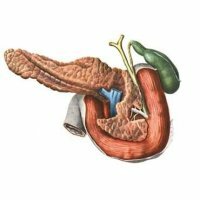Causes and symptoms of umbilical hernia in men
Umbilical hernia is a protrusion in the region of the umbilical ring, measuring from 1 to 20 cm and larger, containing internal organs( intestine, large gland of the peritoneum).In adult men, this pathology is less common than in women and newborns( boys and girls of both sexes).
Hernia is congenital( as a result of a defect in the anterior abdominal wall) and acquired. The latter develops under the influence of provoking factors, leading to increased intra-abdominal pressure against the backdrop of the failure of protective structures( muscle framework and connective tissue).In the early stages, there is no pain and any discomfort. The protrusion disappears completely in a horizontal position, it can easily be adjusted by itself or with the help of a finger.
With the progression of the process, stretching of the umbilical ring, an increase in the size of the hernial sac, which may contain internal organs, complications that require urgent surgical intervention are possible.

Umbilical hernia - a condition in which the internal organs go beyond the umbilical ring
The causes of
- 4.1 Surgical therapy
- 4.2 Conservative therapy
Causes of
Umbilical hernia most oftenDevelops in men older than 40 years.
The main causes of :
- stretching the anterior abdominal wall due to obesity;
- a sharp loss of body weight( weight loss) with a strict diet or severe illness;
- muscle weakness of anterior abdominal wall;
- a sedentary lifestyle with no or little physical exertion;
- periodic very strong physical strain( kettlebell lifting, lifting the bar);
- increase in intra-abdominal pressure during straining, which accompanies the evacuation of the intestine with constipation, increased gas production( flatulence), the presence of fluid in the abdominal cavity( ascites), with severe coughing or sneezing;
- consequences of surgical operations or injuries( falls, auto accident, blows) in the form of muscle damage and ligament apparatus of the anterior abdominal wall.
This congenital pathology with small changes may not manifest itself in childhood. In processes associated with increased pressure in the abdominal cavity, this factor is crucial for the development of the visible umbilical hernia.
Features of clinical manifestations of
The first manifestation of umbilical hernia in men is bulging in the region of the navel of a rounded shape that occurs with physical stress or overeating. In the future, it can appear in an upright position and disappear in the horizontal position. In uncomplicated course there is no pain syndrome, protrusion can be easily inserted into the abdomen.
With a large umbilical hernia, finding a significant area of the intestine in the hernial sac, there are clinical manifestations.
Main symptoms:
- discomfort, pulling pains with physical strain of the abdominals, lifting weights;
- an increase in the size of protrusion in the navel area when coughing, sneezing, straining with bowel movement, after physical exertion, and also gradual decrease after resting in a lying position;
- periodic constipation, possible eructation, minor nausea, rarely - vomiting, as a reflex reaction to the violation of normal progression of the food lump when the part of the intestine enters the hernial sac.
Dangerous consequences and has a brighter symptomatology of complications.
They manifest sequentially in:

Peritonitis - an inflammatory process in the tissues of the abdominal cavity
- Infringement of the hernia.
- Inflammation and impaired blood supply to organs in the hernial sac( usually the intestinal loops), the development of peritonitis( inflammation of the peritoneum).
- Violation of the movement of stool masses through the intestines( coprostasis) until the development of intestinal obstruction.
If part of the intestine or omentum is stuck in the hernial sac, the lumen of the vessels overlaps and not only the movement of the intestine and the pushing of the food lump are violated, but the blood supply of the tissues also stops. This causes necrosis of cells, intestinal obstruction, intoxication of the body, development of peritonitis( inflammation of the peritoneum).If there is no timely help, a rupture of the intestinal wall is possible.
Clinical manifestations of constricted umbilical hernia:
- pronounced pain in the area of protrusion and the near-belly region of the abdomen;
- a sharp increase in hernia in size, the intensity of the protrusion wall, redness of its skin, and local fever and swelling;
- bloating and stool disorder( no bowel movement), hiccough, vomiting;
- increased heart rate, increased blood pressure( at the initial stage and decreased it with the progression of pathology), the overall temperature response.
Diagnosis
To diagnose the development of umbilical hernia, a man should consult a surgeon. During the initial examination, examination and probing the area of the umbilical ring in the supine and sitting position of the patient, the doctor may suspect the presence of an umbilical hernia. With an injured hernia, a sharply painful, uncontrollable protrusion is observed.
A number of instrumental studies are used to confirm the diagnosis:
- an ultrasound examination of the abdominal organs and the peripodal region, which reveals the divergence of the muscles of the anterior abdominal line and reveals the internal organs in the hernial sac;
- herniography( X-ray examination with contrast, allowing to see the sizes and contents of the hernial sac).
If the umbilical hernia is the result of a pathology leading to an increase in intra-abdominal pressure, the treating surgeon, if necessary, sends a consultation to the gastroenterologist, therapist, oncologist.
Approaches to treatment
Surgical therapy
The most modern and effective therapy for umbilical hernia is hernioplasty, in which the plastic of a hernial defect is performed.
The choice of a specific technique is performed by a physician-surgeon individually, based on the size of the hernial protrusion, the state of the muscular and ligamentous abdominal cavity framework, the development of complications, as well as the age and the presence of concomitant chronic men diseases.
Apply:
- tension hernioplasty, that is, the removal of the hernial defect and strengthening of the anterior abdominal wall with the patient's own tissues;
- non-stretching hernioplasty using artificial mesh implants.
According to the method of obtaining access to altered tissues, open operations and laparoscopic operations are distinguished. Open - this is the usual surgical interventions, when the surgeon uses a scalpel to cut the skin, removes the hernial sac, pushes the organs inside.
In case of complications, resection( partial removal) of the affected part of the intestine or omentum is carried out, the abdominal cavity is examined to identify signs of inflammation and other manifestations of the complicated course of the disease, as well as their correction. At the end of the operation, the hernial gates are closed and the anterior wall of the abdomen is strengthened( patient tissues or artificial mesh).

Laparoscopy - the most gentle method of surgical intervention with umbilical hernia
In the laparoscopic method, the surgeon performs several punctures to introduce endoscopic techniques for visual observation and surgical instruments for direct surgery. As with open access, the anterior abdominal wall( more often - the implant) is strengthened in order to prevent the re-formation of the hernia.
The rehabilitation period lasts from 2 weeks to 2 months, depending on the patient's state of health, the duration of the illness and the presence of complications.
Features of the postoperative period:
- daily treatment of a postoperative wound by medical personnel;
- use for the analgesia analgesics( baralgin) and for the prevention of infection with antibiotics( fluoroquinolones, cephalosporins);
- wearing a special postoperative bandage to prevent the effect of pressure in the abdominal cavity on scar tissue;
- absence of strong physical stress( including, sexual activity and lifting of gravity) within 1-2 months, depending on the recommendations of the attending physician.
Sleep better lying on your back, so as not to create excessive pressure on the postoperative area.
Conservative therapy
Therapeutic methods are used to treat boys 1 year of age, as well as contraindications to the operation in men.
Operation is contraindicated in:
- reduction in blood clotting capacity, which does not lend itself to adequate drug correction;
- expressed immunity disorders, for example, with AIDS;
- exacerbations of chronic respiratory diseases;
- severe cardiovascular system, kidney and liver;
- decompensated diabetes mellitus;
- acute respiratory illness( cold, flu).
Conservative treatment in adults does not lead to a cure, but it hinders the progression of pathology.
Applied:
- periodic wearing of the bandage( if physical load is to be performed);
- massages that help to strengthen the muscular wall;
- is a complex of physical therapy aimed at creating a stable protective muscular skeleton in the abdomen.
Children, on the contrary, not only observe the high effectiveness of non-drug treatment, but also self-healing of the umbilical hernia. It is recommended to lay the boy on his tummy for 15 minutes on a hard surface( for example, on a changing table) and perform a light massage or stroking his back, hands and legs. At the age of 2 months, there is a massage of the abdomen, which is carried out by a specially trained health worker.
Also on the appointment of a pediatrician, a temporary application of a band-aid is applied to the navel area. The plaster must be selected special, hypoallergenic. Hernial protrusion gently inward, the rectus muscles approach in the region of the umbilical ring, which fixes the patch. The course of treatment on average consists of a three-fold application of this dressing for a period of 10 days. At the age of 1 year, the doctors examine the boy repeatedly and if the manifestations of hernia persist, the surgeon together with the pediatrician make a decision about possible surgical intervention.
Prevention
Prophylaxis is to maintain normal muscle tone of the anterior abdominal wall and prevent an increase in intra-abdominal pressure.
Basic directions:
- regular physical exercises aimed at strengthening the muscles of the press;
- to refrain from excessive physical stress and lifting weights;
- maintaining normal body weight;
- timely detection and adequate treatment of diseases of the digestive system and respiratory system;
- carefully follow the doctors' recommendation regarding the restoration of habitual physical activity during surgical interventions on the abdominal cavity.
After 50 years, it is advisable for a man to visit a surgeon annually to detect an umbilical hernia at an early stage of development. When the first symptoms appear, it is also important to consult a surgeon who will determine the amount of necessary treatment. This will not only preserve health, but also avoid dangerous consequences.
Recommended for viewing:



